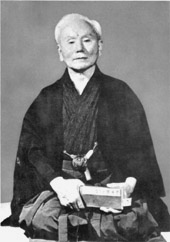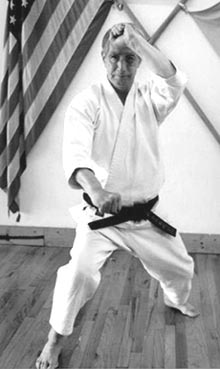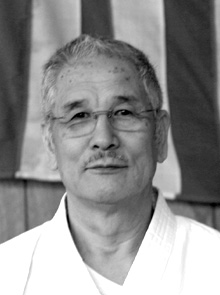|
JKA and the Club
Karate originates from a bare-hand fighting technique
which was passed on from one generation to the next on the island
of Okinawa, Japan. Gichin Funakoshi systematized this fighting technique
into a fully-fledged martial art and dedicated his life to spreading
Karate to mainland Japan.
Karate became a prominent martial art in Japan in the 1920s and it
was spread internationally in the 1960s by Funakoshi's students.
The first karate dojo ever erected in Japan, in 1936, was called Shoto-kan,
a name which Funakoshi's supporters chose because of Funakoshi's pen
name "Shoto". |
 |
| |
Gichin Funakoshi (1868-1957) |
 |
The Shoto-kan was demolished in an air raid over Tokyo
in 1945. Soon after, in 1948, Funakoshi's students gathered together
to form the Japan Karate Association (JKA) in Yotsuya, Tokyo,
with Funakoshi as the honorary head of the organization and with Masatoshi
Nakayama as the Chief Instructor.
Nakayama dedicated his life to spreading Karate internationally with
the help of the many students of Funakoshi who had moved to the U.S.
and to Europe, and the martial art became known worldwide as Shotokan
Karate.
Nakayama's books Dynamic Karate (1966) and the "Best Karate"
book series (1977-1989) have widely popularized Karate. |
Masatoshi Nakayama
(1913-1987) |
|
Hidetaka Nishiyama began training karate in 1943 under
Funakoshi at the Shoto-kan. He was a co-founder of the JKA and was
elected as first Chairman.
In 1961, Nishiyama Sensei moved to the U.S. and he established his
dojo in Los Angeles, California. Since then he has been a major force
in the propagation of Karate in the U.S. and internationally.
He is Chairman of the International Traditional Karate Federation
(ITKF) and President of the American Amateur Karate Federation (AAKF).
In 2000 Nishiyama Sensei was honored by the Emperor of Japan for his
worldwide promotion of Japanese culture as a Master Instructor of
Traditional Karate.
Nishiyama helped popularize Karate in the U.S. with his book Karate:
The Art of Empty Hand Fighting (1960). |
 |
| |
Hidetaka Nishiyama (1928) |
 |
Karate was spread throughout the Midwest primarily due
to Shojiro Sugiyama and his students, who have founded dojos in Illinois,
Indiana, Michigan and Wisconsin.
In 1954, Sugiyama Sensei began training under Nishiyama among other
instructors at the JKA headquarters dojo in Tokyo, after having trained
in two other styles of Karate.
In 1963, Sugiyama Sensei moved to the U.S. to teach Karate at the
request of the Chicago Karate Club, which was sponsored by Walter
Nakamoto. The Club was then renamed to JKA Chicago with Sugiyama
Sensei as Chief Instructor.
Students affiliated to our club can participate in training at the
renowned Sugiyama Dojo in
Chicago, where Sugiyama Sensei and his students hold regular classes
and clinics. |
| Shojiro Sugiyama (1929) |
|
In 1964, Sugiyama Sensei opened the University of Chicago
and Northwestern karate clubs.
Gregory Winston, 4th dan, is the instructor of The University of Chicago
Shotokan Karate Club. Winston Sensei is also an instructor
at the Sugiyama Dojo and has been training under Sugiyama Sensei now
for over twenty years.
Nowadays there are many styles in Karate, among which Shotokan
Karate is the most popular style. Our club teaches Shotokan Karate
in the traditional form in which it was spread by JKA, Nishiyama Sensei
and Sugiyama Sensei. |
 |
| |
Gregory Winston |
SUGIYAMA SENSEI IN THE MEDIA
Sugiyama Sensei's book 25
Shoto-kan Kata (1984) has become a standard reference in the world
of Shotokan Karate, and it includes photographic demonstrations by Nishiyama
Sensei.
|











